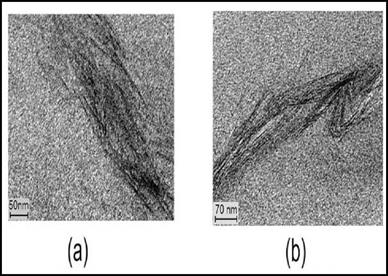TEM complements XRD by observing a very small section of the material for the possibility of intercalation or exfoliation. It also provides information about the particle size and nanodispersion of particles. It however, supplies information on a very local scale. However, it is a valuable tool because it enables us to see the polymer and the filler on a nanometer scale.
Fig. 8 (a) showed a representative TEM image of the PNC3 with a 3 wt% loading percentage of organically modified red mud in the phenoxy matrix, while fig. 8(b) showed a representative TEM image of PRC3. As seen in fig. 8(a), a rather good dispersion of the organically modified red mud is achieved. It is clear that the area covered by the red mud in fig.8 (a) is larger than in fig. 8(b) indicating a more extended platelet separation and an overall best nanodispersion of the critical loading of 3 wt% ORM in the phenoxy matrix.
|
Fig. 26. TEM micrographs of (a) PNC3 (b) PRC3 |
The average particle size was found as 14 nm in case of PNC3 as shown in fig. 26(a), while the size of the particles in PRC3 was found to be 19 nm as shown in fig. 26(b). In fig. 26(b), the nanoparticles showed certain extent of agglomeration and formation of interconnected aggregates or tactoids of silicates.
There may be several fundamental problems that affect the polymer particle interactions in solution, resulting in disordered nanoparticle aggregates. These problems may arise from competing interactions between solvent, polymer chains and filler particles. The conformation of the polymer chains adhered to the nanoparticles also influences the ordered dispersion of the particles.
The presence of the organically modified red mud and phosphomolybdic acid modified red mud with different loading percentage and dispersing capabilities, may help us to identify the main structural driving force for dispersion in these Phe based PNs. It has been reported that the interaction between the polymer chains and the inorganic surface of the clay (Fornes et al., 2004) is crucial in polar polymers, and therefore it could also exist between the polar Phe and the modified red mud surface. Good dispersion of modified red mud in the polymer matrix will have a significant effect on the properties of the nanocomposites.




